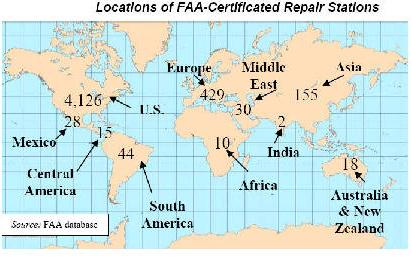
NEWSROOM
 |
NEWSROOM |
|
|
|
|
|||
|
DOT Calls For
Greater Oversight At Aircraft Repair Stations
|
||||
 |
November 19, 2009 - The Inspector General testified on the Federal Aviation Administration’s (FAA’s) oversight of repair stations. It was noted that air carriers’ use of repair stations has risen dramatically in the last several years. Both in the volume and type of repairs outsourced. The Office of Inspector General (OIG) reported since 2003 that FAA’s oversight of aircraft repair facilities is not robust enough to ensure that outsourced repairs meet FAA standards.
Specifically, the
FAA does not know where all critical outsourced repairs are performed,
for both certificated and non certificated facilities.
|
|||
|
Successfully
implementing these recommendations would allow FAA to identify and
target repair facilities in need of safety oversight as well as meet its
statutory mandate to provide TSA with information needed to improve
security oversight.
Repair stations conduct a range of repairs and maintenance, from
critical components—such as landing gear and engine overhauls—to heavy
airframe maintenance checks, which are a complete teardown and overhaul
of the aircraft. Currently, there are 4,858 FAA-certificated repair
stations, 4,126 of which are located in the
Air carriers’ use of repair stations has risen dramatically in the last
several years—both in the volume and type of repairs outsourced. Between
1996 and 2008, the percentage of outsourced maintenance increased from
37 percent to 64 percent (based on dollars spent). The first two
quarters of fiscal year (FY) 2009 indicate that this trend is likely to
continue, as 63 percent of maintenance expense was outsourced as of June
2009.
Nine major air carriers reviewed sent 71 percent of heavy airframe
checks to repair stations in 2007, up from only 34 percent in 2003.
Foreign repair stations performed 27 percent of this work, compared to
21 percent in 2003.
Safety oversight gaps have been reported by OIG, they have identified
security vulnerabilities at repair stations located at commercial and
general-aviation airports and off-airport property. OIG issued a report
in 2003 disclosing these vulnerabilities and recommended that TSA and
FAA assess repair stations to identify the greatest security
risks—including susceptibility to sabotage—and develop security programs
appropriate to the significance and criticality of the work performed.
|
||||
|
Implementing
effective security programs would be a challenge for both TSA and FAA
because foreign facilities are not subject to
Due in part to our
recommendations in 2003, Congress enacted FAA’s 2003 Vision 100 Century
of Aviation Reauthorization (Vision 100), which mandated TSA to complete
large-scale security reviews of FAA-certificated foreign repair stations
and issue final regulations by August 2004 to improve the security of
foreign and domestic repair stations. TSA did not meet the 2004
deadline.
In the August 2007
9/11 Commission Recommendation Act, Congress included a provision that
if TSA did not issue a repair station security rule by August 2008, FAA
would be barred from certifying any new foreign repair station.12Again,
TSA was not able to meet the deadline, and FAA was barred from
certifying any new foreign repair stations. However, TSA announced on
November 16, 2009, that its proposed rule is now open for public
comment.
Pending
legislation would address regulatory gaps in oversight of Foreign Repair
Stations. Congress is introducing new bills to close other regulatory
gaps between foreign and domestic repair stations that we have
identified in our past work. While FAA verifies that approved repair
stations have the equipment, personnel, and inspection systems to ensure
that repairs are completed according to FAA standards, the repair
stations are under the regulatory control of the government of the
country in which they are located. As a result, there are some
regulatory differences between domestic and foreign repair stations.
Machinists Call
for One Level of Aircraft Safety and Security.
“Since 9/11 we have tightened up
the physical security at
“But allowing
The Machinists
Union used the hearing, titled is the Flying Public Protected? An
Assessment of Security at Foreign Repair Stations, to shed light on some
major safety and security lapses that occur at overseas maintenance
repair stations, including the lack of security standards, no required
criminal background checks of workers and the FAA practice of announcing
repair station inspections months in advance.
“The lowest cost,
not the highest safety standards, is the driving force when airlines
choose maintenance repair stations,” said Roach. “The Machinists Union
believes there should be only one level of safety and security – the
highest - for
Less oversight
means less money. If overseas repair stations and their employees cannot
meet the same requirements as the airlines’ U.S.-based operations,
Congress should mandate that work be performed within our borders where
there is more FAA regulation and oversight.”
|
| ©AvStop Online Magazine Contact Us Return To News |